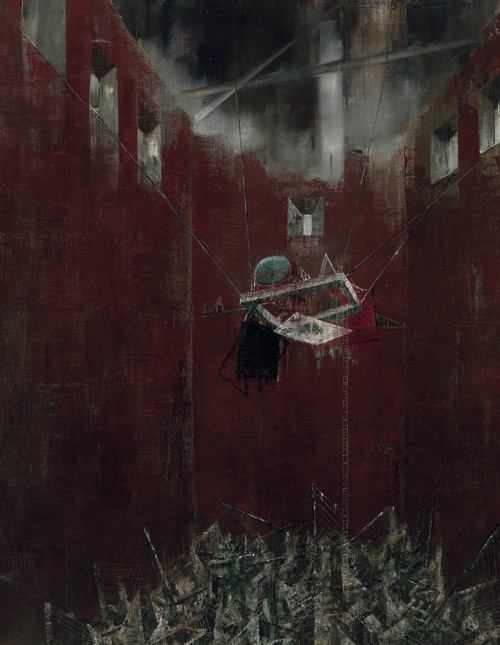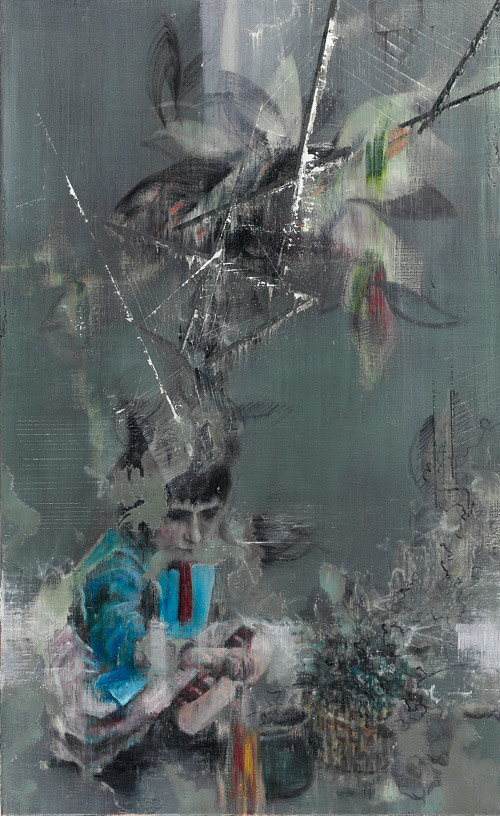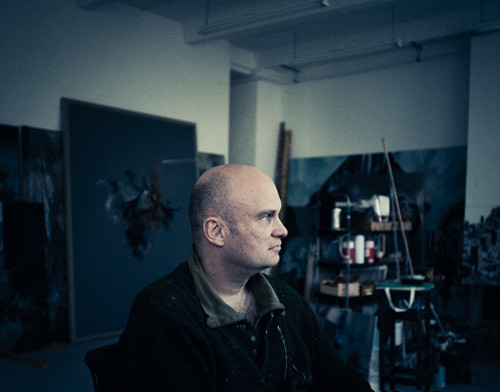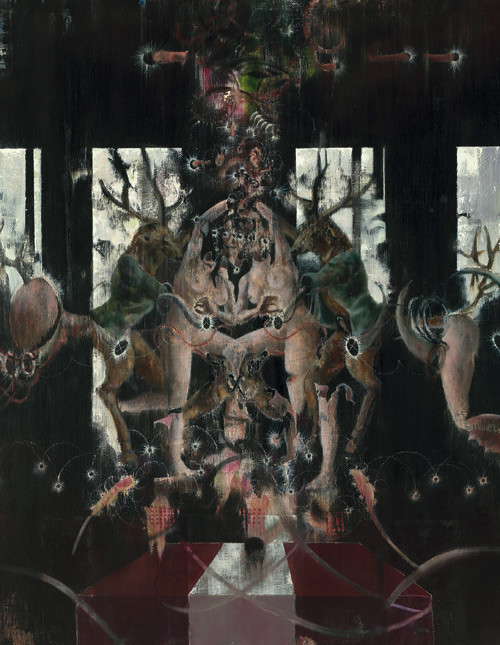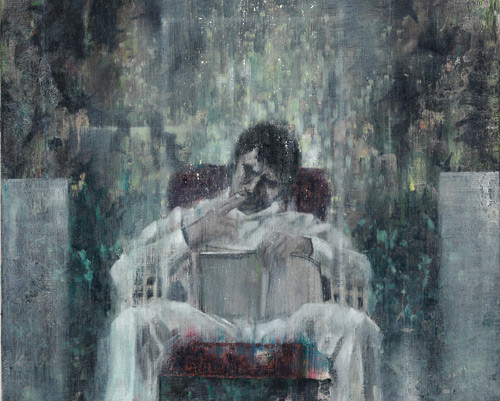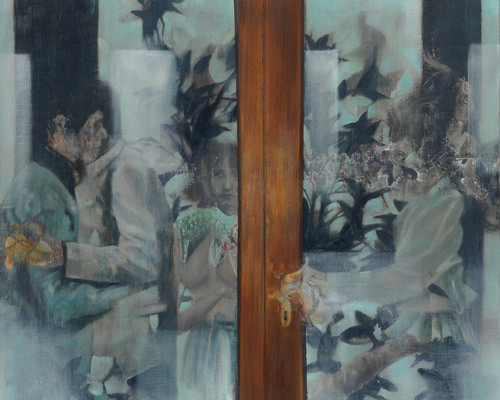Michael Kunze seeks the hidden paths in Western culture
Published: January, 2011, ZOO MAGAZINE #30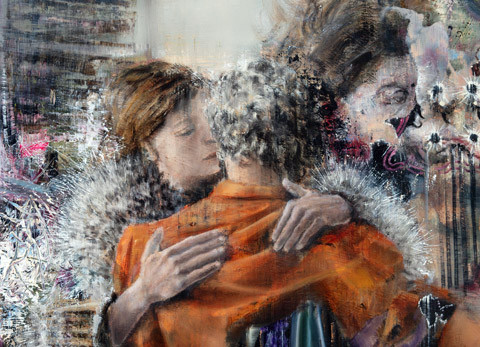
In the last two years, German painter Michael Kunze has let the wider public in on his striking talent. Working from his Berlin studio, he has created complex, rich and powerful paintings that are as mysterious and surprising as the artist himself. Monumental canvases seduce the innocent eye, only to shock it with their stormy ideas and concepts—catapulting viewers from their comfort zone.
Marta Gnyp: I have visited your studio several times over the years. What has always surprised me is your enormous energy and fantasy; you are able to create something new every time, despite working with the traditional medium of painting, which was declared dead in the 80s. What made it survive for you, and why is it such an important medium?
Michael Kunze: Like so often in life, one can say here that every disadvantage has its advantage. An anachronistic medium like painting is up to date when one brings this anachronism into the spotlight instead of hiding it. The more digital our world becomes, the more interesting it is. Also important for understanding our actual position is to penetrate the internal structures of an analogue procedure through which we use to understand and recognize our world in the past. The history of this analogue construction of the image is very long and complicated. Therefore, if you use this old medium today—and by doing so, if you refer to this whole historically-embedded concept of painting—you can get the most intense and surprising results. In this way, the old medium becomes a sort of corrective of the new media.
MG: In the last 20 years, we have seen the revival of German painters such as Leipziger and Dresdner Schule. Can we discuss the Berliner Schule?
MK: Since then, there have been so many artists and people from all over the world involved in art in Berlin that a unique style cannot exist anymore. The more heterogeneous the scene, the better for artists and for spectators. The spectator can follow his own instincts to judge what he sees and what he considers worth seeing; he doesn’t have to rely on the prevalent discourse for making his own choices.
MG: How important is it for you as an artist to live in Berlin?
MK: It is a good place for exchanging opinions.
MG: Why did you become an artist?
MK: I began by studying art history and literature at university. But after a while, it was like I was walking without exactly looking at which direction I was going. So I changed sides and continued the walk by making art. From that moment on, I started to construct the sort of images I’m still working on.
MG: You seem to be interested in the ancient roots of our Western culture. How ‘German’ is your painting?
MK: One can distinguish two ways in the western culture: One, the Anglo-Saxon way with all the well-known, pop-cultural superficialities and its pragmatic and positivist adaptations that largely determine our contemporary world. The other, Eurocontinental way is more difficult, more hidden, almost forgotten in large parts of our daily life. But here, we find a complicatedly connected reservoir of idealistic, metaphysical and ambiguous approaches that call positive phenomena into question by plenty of ‘negativist’ (not in a moral sense!), fantastic, sometimes also dangerous propositions. Here, the culture is more a ‘high’ thing—a confusing challenge and not a popular and entertaining attitude. It’s clear that my interest lies in this second, Euro-continental way. And for sure, the German contribution to Western culture is to be found in this second way as well. Everything that has been interesting coming from Germany in the last 200 years has been difficult and complicated. Pop, however—the famous five minutes of fame proposed by Warhol—is an Anglo-Saxon invention and the complete opposite of Hegel, Nietzsche and Heidegger. Perhaps both sides need each other.
MG: Your interest in hidden, less popular paths resounds in your theory about modernism in the visual arts as well. There is one path that became official history of modernism—from Cezanne through the avant-gardes of the 20s and neo-avantgardes of the 60s. And the other path starting—with Böcklin through De Chirico, Balthus the outsiders of the mainstream concerned with the image—to the film works by Antonioni, Bergman or Pasolini. The last path has no central clear concept: there is no progress in the development of this line; it is more like a labyrinth. You seem to be especially interested in this second shadow line of modernism, why?
MK: In this shadow-line of modernism lies all the motifs and historical references that present another image of the world other than the mainstream modernity we are accustomed to. It’s a sort of anti-modern modernity, a dark but rich and large cloud, from Nietzsche’s tragedy studies to Lars von Trier’s Antichrist. And the more we can discover of this confusing context, the more we can also understand the apparent ‘light-line’ that is often based on errors and contradictions about which nobody is allowed to talk.
MG: Do you think that the dark and irrational side of man says more about the human condition than rational conscious thinking?
MK: I’m not sure if the opposition rationalirrational is still usable today. It is one of the errors I just mentioned. Although many had tried to correct this wrong opposition —from Greek antiquity through Hšlderlin to Nietzsche, to mention a few, it remains a challenge for us to find this track again. We need to reflect over the boundaries and limits of concepts that are too comfortable and can easily deceive us.
MG: You construct strange images with their own logic, breathtaking perspectives, flying objects, swirling figures. You make huge architectonic landscape paintings in which one can lose himself. Your architecture seems to hide many secrets that we can sense but never truly see. Where does your inspiration come from?
MK: All these aspects refer to the historical roots of the aforementioned distinction. For me, nothing is real and as certain as one thinks it seems to be. Progress can be understood as an illusion if one realizes that the exit from a labyrinth is always a construction. The big simulation-machine wherein we live makes everything that seems to us so near and clear completely incomprehensible.
MG: In your last series, one of the main topics was the artist in his studio, or actually, the absence of the artist in his studio. Did you intend to position yourself as an artist and to define who is the artist today, like the stranger in Pasolini’s Teorema, whose function is to break the old structures and disclose what is behind?
MK: Although the artist today seems a superfluous person, he can remind us, for example, of the half-forgotten cultural context I mentioned before. He can make us aware of invisible absurdities in the simulationmachine and open superfluous windows by a superfluous medium in a superfluous game. Then suddenly, we can recognize that the endless perspective which we see on the screen when playing with invented enemies simply continues the idea of the enormous prison from Piranesi, who went crazy about the greatness of the antique ruins in Rome, perhaps looking out of or into Plato’s cave.
MG: Did you ever meet a stranger like the one in Teorema, who suddenly pushed your life in a different direction?
MK: I would say every day you meet such a stranger several times, but normally you don’t notice him because most of the time he is invisible.
MG: In most of your paintings, there is a kind of signature, a three-legged strange object with a circle on top. What does it mean and when did you start to use it?
MK: It is a stylized tripod, a device used by photographers or land surveyors that provides a fixed standing point. Everybody is longing for such a fixed standing point! You can also read it as an ironic quotation against any possibility to fix the point. And also as a formal gesture—an image of exactness; an idea of a clear drawing, of a geometric theatre, a small cut or carve in a somehow disorderly neighborhood.
MG: In some of your series, you painted dark deformed figures—people with Down’s Syndrome, frightening creatures, architectural, monumental landscapes with apocalyptic scenarios. In other series, there are blue skies, white walls; one can see the beauty of abstraction and sense your humor: failed utopias and destruction versus optimism. Are you an optimist yourself?
MK: The figures refer to the TV series of Lars von Trier’s Kingdom, which partially formed the context of my series, What is Metaphysics? The architectural scenes were located between the futuristic memory of antiquity and the totalitarian implications of modernity, in which function and practicality must be visible. But what we see are only absurd details. And what starts with a ‘roof over the head’ ends up as a gigantic cenotaph, where the monumental aesthetics of a fantastic pagan culture crosses the architecture of war and modern visions of a new society and mankind, for example the Russian supremacists. Optimistic? For sure! Like the monk on the seaside in the famous painting of C.D. Friedrich, or the invisible inhabitant of Böcklin’s Villa am Meer—the more darkness behind, the more hope and confidence in front.
Michael Kunze is represented by Contemporary Fine Arts Galerie, Berlin.
